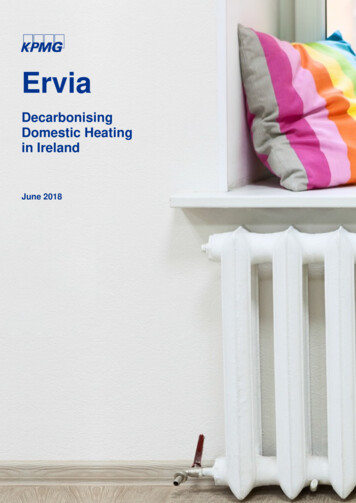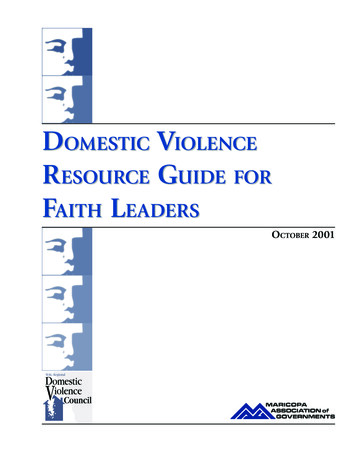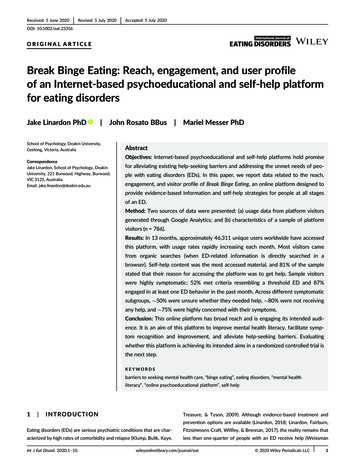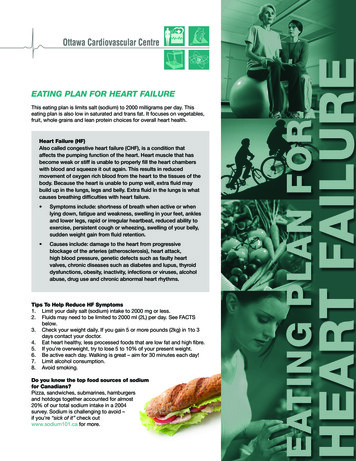
Transcription
ErviaDecarbonisingDomestic Heatingin IrelandJune 2018Document Classification - KPMG Public
Important noticeKPMG wish you to be aware that the work it carried out for Ervia was performed to meet specific termsof reference agreed with them, and that there were particular features determined for the purposes ofthe engagement and the needs of Ervia at the time. The report should not therefore be regarded assuitable for use by any other person or for any other purpose. Should you choose to rely on the reportyou do so at your own risk. KPMG will accordingly accept no responsibility or liability in respect of it topersons other than Ervia.We have not verified the reliability or accuracy of any information obtained in the course of our work,other than in the limited circumstances set out in our Engagement Letter with Ervia.Document Classification - KPMG Publici
ContentsGlossary43Abbreviations 451Executive summary41.1Context41.2Conclusions72Decarbonising heat in Ireland92.1Introduction92.2The Irish Gas Network102.3Ireland’s Decarbonisation Targets112.4Greenhouse Gas Emissions112.5Chapter Summary123Scenarios for residential decarbonisation133.1Technology options for decarbonising heat133.2Scenario Development173.3Our scenarios: the specifics203.4Chapter Summary254Approach264.1Our approach to cost assessment264.2Our approach to feasibility assessment264.3Chapter summary275Findings285.1Gas Decarbonisation (Biomethane)285.2Gas Decarbonisation (Biomethane & Hydrogen)305.3Electrification of heat32Document Classification - KPMG Public2
5.4Chapter summary346Conclusions356.1Scenario comparison356.2Comparative feasibility assessment376.3Overall conclusions38Appendix 1 – Assumptions40Document Classification - KPMG Public3
1Executive summaryScope of this ReportErvia, the parent company of Gas Networks Ireland, commissioned KPMG to develop and evaluatea number of scenarios for the decarbonisation of the one million Irish residential homes currentlyconnected, or within close proximity, to the existing gas network.1.1ContextIreland has an ambitious vision to transform into a low carbon society and economy by 2050. Whilesignificant progress has been made to date in the decarbonisation of industrial energy and electricitygeneration, there is a recognition that more can, and must be done to address other areas such asheating and transport, which also generate significant volumes of greenhouse gases. This reportfocuses on one of these areas, namely the decarbonisation of the residential heating sector.The methodology employed in this report is similar to that employed in a 2015 study by KPMGcommissioned by the Energy Networks Association (“ENA”) on future alternative 2050 scenarios forenergy decarbonisation in the UK 1.We have developed a series of high level decarbonisation scenarios and have made an assessmentof the feasibility and cost of each one. The costs of transitioning to these scenarios are measuredagainst a “Do Nothing” baseline, where the energy system continues in largely the same form astoday. Our approach to developing an evidence base has been to use the assumptions developedfor the UK study, unless an Ireland specific source exists.While there are two million residential homes in Ireland 2, this report is specifically focussed on thecirca 700,000 currently connected to the gas network and the 300,000 homes within close proximityto it. The scope of this analysis excludes the circa one million homes which cannot be connected tothe network without significant network expansion, and on which a separate decarbonisationstrategy will have to be considered.1.1.1 Scenarios for analysisWe have selected three potential scenarios to show how domestic heat demand from the one millionproperties either currently connected to or in close proximity to the gas network can be significantlydecarbonised by 2050. The scenarios are described in Table 1.1 below.Table 1.1: Description of scenariosScenarioDescriptionGas Decarbonisation Current gas network extended to 300,000 homes (nearly all of which currently use oil(Biomethane)heating) within close proximity of the network so that the total number of connectionsreaches one million.Renewable gas replaces natural gas from 2018, with material quantities availablefrom 2025 onwards.Gas Decarbonisation Current gas network extended to an additional 300,000 homes within close proximity(Biomethane &to the network, so that the total number of connections reaches one million.Hydrogen)Renewable gas gradually replaces natural gas from 2025 on most of the network. Inthe Cork area, 100,000 households receive hydrogen - this conversion takes tem.htmlCentral Statistics Office, 2016Document Classification - KPMG Public4
ScenarioDescriptionbetween 2035 and 2040. Hydrogen is produced through Steam Methane Reformers(“SMRs”). The CO2 produced is captured and stored in the depleted Kinsale gasfield.Electrification ofHeatHeating systems in homes are electrified from 2025 onwards, with the electricitysourced from new renewable electrical generation. Domestic demand for natural gasdeclines and the gas distribution network is decommissioned.Table 1.2: Summary analysisScenarioTechnologiesDeployedFinancial Impact CO2 Emissionsper Household Mitigated (‘000 tnsper annum)1. GasDecarbonisation(Biomethane)Biomethaneproduced by AD asa principal lowcarbon alternativeto natural gas 5,300 – 7,600*2,690 (93%)** including GHG savingswithin the biomethane,as well as savings with* Average discountedthe agricultural sector.cost per householdExcludes further savingsbetween now andfrom displacement of2050 includingcombination of capex synthetic fertiliser, whichwould provide additionaland increasedGHG savingsenergy costs.Refers to percentagesaving Vs today’sbaseline GHGemissions.2. GasDecarbonisation(Biomethane &Hydrogen)Biomethaneproduced by ADand hydrogenthrough SMR asprincipal lowcarbon alternativesto natural gas. 5,500 – 8,000*2,706 (93%)** including GHG savingswithin the biomethane,as well as savings withthe agricultural sector.Summary of FeasibilityAssessmentProven technology, with nochange required atconsumer or network levelcompared to existing naturalgas usage.Meeting the heat demand ofone million homes withbiomethane will requireconsiderable waste andgrass silage resources thatare complimentary with agrifood production (e.g. slurries,crop residues, rotation/catchcrops) or increase utilisationof lower productivity grassland.Significant new AD plantconstruction and a policysupport mechanism wouldlikely be required.Able to meet all current &expected EU GHG efficiencyrequirements.Hydrogen is not yet provenat a mass market level sogradual roll-out and testingwould be required. Thesame would apply to a largeCCS facility. Consumersusing hydrogen would alsoneed new appliances.However, no additionalspace would be requiredbecause current boilers willbe replaced with gasappliances which arecompatible with hydrogen.Excludes further savingsfrom displacement of* Average discountedsynthetic fertiliser, whichcost per household would provide additionalbetween now andGHG savings.2050 includingRefers to percentagecombination of capexNew plant to producesaving Vs today’sand increasedbaseline GHGbiomethane would beenergy costs.emissions.required at scale, as well asDocument Classification - KPMG Public5
ScenarioTechnologiesDeployedFinancial Impact CO2 Emissionsper Household Mitigated (‘000 tnsper annum)Summary of FeasibilityAssessmenta new policy supportmechanism.3. Electrification of Homes currentlyHeatsupplied with gasfor heating willinstead have heatpumps suppliedwith electricity. 14,350 – 19,600*2,861 (99%)*Proven technology. Subjectto sufficient investment inadditional renewableelectrical generation, able toprovide significant reductionin GHG emissions.Achievable under currentregulations.Requires expensive, deepretrofit of houses to achieveenergy efficiency levels* Assumes all electricity required for heat pumpcomes from renewable technology. Additionalspace requirements for the* Average discountedsources. Giventechnology may prohibitcost per household intermittent nature ofwindandsolar,smaller properties.between now andsignificant battery2050 includingConsumer acceptancecombination of capex storage would berequired to achieve this challenges since low heatand increasedwithout baseload fossil output.energy costs.backup. This reportIncreased peak demanddoes not include the costwould require significantof battery storage, whichcould be very significant. electricity networkinvestment, along withelectricity storage, smartmeters or alternative smartgrid solutions, which wouldrequire significantinvestment.The costs per household are also summarised in the chart below:Cost per household ( ), total costs (capital investment and fuel) to 2050, discounted, current prices25,000 20,00015,00010,0005,000Gas Decarbonisation(Biomethane)Gas Decarbonisation(Biomethane & Hydrogen)Low CostElectrification of HeatHigh costDocument Classification - KPMG Public6
1.2ConclusionsOur analysis draws the following main conclusions:Decarbonising the domestic heating sector will incur significant consumer cost,regardless of approach or technologyAny decarbonisation pathway for domestic heat will create costs relative to a ‘Do Nothing’scenario, where heat demand continues to be met by fossil fuels. Each of our threedecarbonisation scenarios incur significant cost, which will ultimately be borne by consumersthrough higher renewable levies, higher energy prices or upfront capital investment in generatinginfrastructure and housing energy efficiency conversions.Policy makers will have to demonstrate the rationale and benefit to consumers of acceptingthese higher costs to ensure sufficient public support and acceptance.Utilising low carbon biomethane within the existing gas network is the lowest cost way ofdecarbonising heat for homes connected to or in close proximity to the gas networkOf our three scenarios, utilising low carbon biomethane within the existing gas networkrepresents a lower cost alternative to either electrification or a biomethane / hydrogen mix.Furthermore, our analysis also suggests that extending the gas network to the c.300,000 homesin close proximity to the existing gas network (‘network infilling’) represents a lower cost optionthan electrification for these homes. Our estimate of the cost per household of creating a lowcarbon gas distribution network serving one million customers is roughly one-third of convertingthese properties to electric heat. This is before we consider energy storage which is likely to berequired for electrification and which would add considerable expense.Low-carbon gas is the least disruptive way of decarbonising domestic heatingConsumer acceptance is an important consideration in selecting a decarbonisation technology orscenario. At a household level, low carbon gas does not require the ‘deep retrofit’ needed toconvert properties to electric heat (e.g. installation of underfloor heating / high levels ofinsulation), nor are new appliances or internal infrastructure required. Although a deep retrofit isnot needed, Ervia and KPMG are including significant energy reduction measures in all housesconnected to the network. Furthermore, the low carbon gas scenario does not require extensivenetwork reinforcement to meet peak demand.Meeting heat demand through low-carbon gas will require extensive use of Ireland’snatural resources and a very ambitious deployment of anaerobic digestion technologyProducing the requisite quantities of renewable gas to meet domestic heating requirements willrequire the use of considerable quantities of grass silage feedstocks and agricultural wastes, aswell as construction of significant AD processing facilities. While studies suggest we can sourcethe required volumes without impacting current land use, Ireland’s energy and food needs willneed to be considered holistically to ensure the correct balance in land use.Document Classification - KPMG Public7
Low-carbon gas can be a highly secure decarbonised heat supplyIreland’s gas networks are highly reliable, even in severe weather conditions where there can bea loss of electricity supply. Renewable gas, in particular biomethane, can provide an indigenoussource of energy for the country at scale. Furthermore, the costs presented in this report do notreflect the value of the inherent flexibility of gas, nor the costs of ensuring that electricity supply issufficiently flexible to provide heat on demand. With high levels of intermittent renewables beingproposed for and implemented in Ireland, sources of reliable supply will be required to meetdomestic heat demand.Hydrogen holds potential, but remains a developing technologyWhile it holds significant potential to provide decarbonised gas, there are also considerablechallenges to deploying low-carbon hydrogen as a heating fuel. The lowest cost method ofproducing hydrogen is through the SMR process. However, this produces CO2 as a by-product,meaning that SMR units must be fitted with Carbon Capture kit and connected to a CO2 transportand storage network. CCS networks are complex projects, with a range of risks that are difficultto manage. As a result of these complexities, there has been limited development of CCSprojects globally to date.Development of the sector will bring significant societal benefitAs well as assisting in the decarbonisation of the economy, the development of an indigenousanaerobic digestion industry has potential to transform large parts of Ireland’s rural economy.Not only will it stimulate high value infrastructure investment across a decentralised andgeographically disbursed rural area, it will also create and support significant construction andengineering roles within the wider economy.Policy Implications & Recommendations1. Recognition that the decarbonisation of heat in Ireland represents an importantelement of Ireland’s overall decarbonisation strategy, and that appropriate policysupport is introduced to support its implementation;2. Adoption of a joined up approach across government to deliver biomethanedecarbonisation including appropriate energy policy, planning policy, wastemanagement policy and appropriate financial support mechanisms;3. Ring fence the carbon tax on natural gas to support production of renewable gas;4. Base Irish energy policy on total system costs to the consumer (including impact onconsumer bills, consumer capital expenditure and the exchequer), rather than solelyon costs to the Exchequer, as is currently the case;5. Adopt the same approach to financially support the production of renewable gas aselectricity by introducing a gas PSO levy. Alternatively, introduce support forbiomethane grid injection within a renewable heat incentive scheme.Document Classification - KPMG Public8
2Decarbonising heat in Ireland2.1IntroductionIreland has an ambitious vision to transform into a low carbon society and economy by 2050. Whilesignificant progress has been made to date in decarbonisation, particularly in industrial energyusage and electricity generation, there is a recognition that more can and must be done to addressother areas such as heating and transport, which also generates significant volumes of greenhousegases. Failure to meet Ireland’s ambitious long term decarbonisation targets would result insignificant financial penalties which means that a ‘Do Nothing’ approach is not an option.Against this backdrop, KPMG has been commissioned by Ervia to develop and evaluate a numberof scenarios for the decarbonisation of one of these key emission areas, namely the residentialheating market. Ervia is the commercial semi-state multi-utility company responsible for Ireland’snational gas infrastructure through Gas Networks Ireland. Specifically, Ervia has asked KPMG tofocus on the one million Irish residential homes currently connected (circa 700,000), or within closeproximity (300,000) 3, to the existing gas network. The scope of this analysis therefore excludes thecirca one million homes which cannot be connected to the network without significant networkexpansion, and on which a separate decarbonisation strategy will have to be considered.In 2015, KPMG prepared a report for the UK’s Energy Networks Association (“ENA”) on futurealternative 2050 scenarios for energy decarbonisation in the UK, with a particular focus on gas. Thereport concluded that regardless of the technology, significant investment would be required todecarbonise the residential heat sector, but continuing to use the gas network offers significantsavings versus alternative heating sources. The report further concluded that careful considerationmust also be given to any alternative heating sources to ensure any changes are embraced byconsumers.The methodology employed in this report is similar to that employed in the 2015 UK study notedabove. We have developed a series of high level decarbonisation scenarios and have made anassessment of the feasibility and cost of each scenario. The costs of transitioning to thesescenarios are measured against a “Do Nothing” baseline, where the energy system continues inlargely the same form as today. Our approach has been to use the assumptions developed for theUK study, unless an Ireland specific source exists, as the UK assumptions are expected to remainrelevant and appropriate when used in an Irish context.We recognise that in reality the energy system is highly unlikely to develop according to oneparticular scenario that we can set out today. The purpose of having these scenarios is to show arange of possibilities, and to this end we have deliberately chosen contrasting scenarios. Real worldexperience is likely to see a combination of scenarios in varying proportions.2.1.1ExclusionsWe would draw attention to a number of exclusions within the scope of this study:— We have only considered emissions of CO2 in this study, which accounts for the majority ofgreenhouse gas emissions. We assume that other greenhouse gas emissions are proportionalityreduced but we have not investigated this further.— While we have set out the relative costs of decarbonisation under the various scenarios, wehave not offered an opinion or analysis on the societal value for money of such decarbonisationoptions. Given the significant costs involved under any scenario, such an assessment will needto be made at community and political level.3Source: Gas Networks IrelandDocument Classification - KPMG Public9
— We have not considered the additional cost of electricity storage in our assessment ofelectrification of heat.— While we discuss a number of decarbonisation technologies, including electrification anddecarbonised gas, we have not undertaken primary research on the feasibility of eachtechnology and have instead utilised existing research and reports which are clearly identifiedwithin this report.This chapter sets the context for the report by providing an overview of the Irish gas network,Ireland’s decarbonisation targets and the current status of greenhouse gas emissions (“GHG”) inIreland.2.2The Irish Gas NetworkFigure 2.1: Gas Networks Ireland MapSince the scope of this report focuses on the one millionhomes on or within close proximity to the Irish gas network, itis helpful to provide a summary of the existing gas networkand its geographic location.Both the gas transmission and distribution pipelines acrossIreland are owned and managed by Gas Networks Ireland, asubsidiary company of Ervia.Currently, gas plays a key role in Ireland’s energy system,providing approximately 27% of the country’s primary energyneeds 4. It provides an effective source of heat forhouseholds and businesses which are connected to the gasnetwork, and is safe and modern by global standards 5.As outlined above, this report is focused on twogeographies, being areas connected to the gas network and areas located in close proximity to thegas network. Gas Networks Ireland currently serve approximately 688,000 customers in Ireland. Inaddition it is estimated that 200,000 homes are on streets where gas is available and another100,000 homes are in estates near to a gas supply. When considering decarbonisation scenarios,this report therefore assumes that a total of one million homes in the Republic of Ireland areconnected to the gas network to allow for moderate growth, for ease of explanation and to simplifythe analysis.Residential heating currently comprises around half of Ireland’s overall heat demand 6.Approximately 97% of households in Ireland were centrally heated as of 2011, with oil and gas beingthe dominant fuels for providing heating 7. Ireland’s gas networks have grown, particularly in urbanareas, with approximately 39% of Irish households now connected to the gas grid as of 2014 8. Bycontrast, electric central heating is relatively uncommon in Ireland with just 9% of households usingelectrical storage heating 9.4Page 12, SEAI, Energy in Ireland 1990-2015.For example, in 2016, Ervia reported a consistently high safety performance on its distribution network, with only 1 gas inbuilding event, 3 unplanned outages and no gas supply emergencies6Energy Institute, ‘The Story of Heating in Ireland’, http://ireland2050.ie/past/heat/.7Energy Institute, ‘The Story of Heating in Ireland’, http://ireland2050.ie/past/heat/.8Houses of the Oireachtas, Written Answers 282-300, 1 July 100064.9http://ireland2050.ie/past/heat/.5Document Classification - KPMG Public10
2.3Ireland’s Decarbonisation TargetsIreland has ambitious long term decarbonisation targets which have been developed in the contextof the significant role played by both Global and European institutions in determining energy policy,markets and regulation.On a Global scale, Ireland is a party to the United Nations Framework Convention on ClimateChange (“UNFCCC”) and to the Paris Agreement, which provide the international legal frameworkfor addressing climate change at a global level. The ultimate objective of UNFCCC is the“stabilisation of global GHG concentrations in the atmosphere at a level that would preventdangerous anthropogenic interference with the climate system” 10.Within the EU context, the 2020 climate & energy package has set a binding EU wide target of a20% reduction in GHG emissions from 1990 levels. This target is increased to 40% by 2030 underthe 2030 climate and energy framework of October 2014. The European Commission has alsodeveloped a low-carbon economy roadmap which suggests the EU should cut greenhouse gasemissions by 80% below 1990 levels. The EU’s Effort Sharing Decision also set 2020 targets for EUMember States in relation to GHG emissions from sectors not included in the EU Emissions TradingScheme (“ETS”) (i.e. agriculture, transport, the built environment, waste and non-energy intensiveindustry). Ireland has a 2020 target to achieve a 20% reduction of such non-ETS sector emissionson 2005 levels.The Global and EU objectives have been implemented in Ireland though the National Policy Positionon Climate Action and Low Carbon Development 2014 and the Action and Low CarbonDevelopment Act 2015. The National Policy Position establishes the fundamental national objectiveof achieving transition to a low carbon, climate resilient and environmentally sustainable economy to2050, and envisages a reduction in GHG emissions from the energy sector by at least 80%compared to 1990 levels. The Climate Action and Low Carbon Development Act 2015 provides thestatutory basis for Ireland’s transition.2.4Greenhouse Gas EmissionsAs noted above, Ireland has made significant progress in decarbonisation in recent years,particularly in industrial energy usage and electricity generation. Between 2005 and 2014, Irelandreduced total GHG emissions by more than 17% 11. However, it is estimated that non-ETS sectoremissions are projected to be only 4% - 6% below 2005 levels by 2020 12, substantially below the2020 target of 20% set by the EU.The main sources of Ireland’s GHG emissions and the sources of heat demand are illustrated below:10Article 2, The United Nations Framework Convention on Climate /ep/p-eii/eii2016/ggcc/.12Environmental Protection Agency: Ireland’s Greenhouse Gas Emission Projections 2016 – 2035, April 201711Document Classification - KPMG Public11
Figure 2.2: Greenhouse gases by Sector 13 and Heat Demand gy industriesResidentialDomestic space / water heatingIndustryCommercial / public buildingsManufacturing, industrial and otherEnergy related emissions comprise more than 60% of total emissions and include energy industries,transport, residential, manufacturing, industry and commercial sectors. The majority of the nonenergy emissions are from the agriculture sector.The “Residential” sector contributed c.10% of total GHG emissions, and so there is scope forsignificant further reductions in GHG emissions through the decarbonisation of residential energyuse.The “Residential” sector includes the greenhouse gases related to combustion for domestic spaceand hot water heating (using gas and other fuels), and so the transition to decarbonised residentialheating would need to consider the impact of changes required in each home that will need to facethe cost and disruption associated with substitution of energy sources.2.5Chapter Summary— Residential heating currently comprises around half of Ireland’s overall heat demand. The“Residential” sector contributed to c.10% of Ireland’s GHG emissions in 2015.— Approximately 39% of Irish households are connected to the gas grid as of 2014. This reportassumes a total of one million homes are connected for the purposes of consideringdecarbonisation scenarios.— Ireland is targeting a reduction in GHG emissions from the energy sector by at least 80%compared to 1990 levels by 2050.— Between 2005 and 2014, Ireland reduced total GHG emissions by more than 17%. However,non-ETS sector emissions are projected to be only 4% - 6% below 2005 levels by 2020,substantially below the 2020 target of 20% set by the EU.13Environment Protection Agency: Ireland’s Final Greenhouse Gas Emissions in 2015, 13 April 2017Percentage shares approximate, based on text in Energy Institute, ‘The Story of Heating in ment Classification - KPMG Public12
3Scenarios for residentialdecarbonisationIn this section of the report we describe the basis of the scenarios we have evaluated for the futuredecarbonisation of domestic heating. This section is structured as follows:— Section 3.1 sets out the principal technology options for decarbonising domestic heat in Ireland;— Section 3.2 sets out the rationale for the scenarios analysed in this report; and— Section 3.3 provides detail for each of the scenarios.3.1Technology options for decarbonising heatPrior to the development of specific scenarios to be assessed within this report, it was necessary toundertake an assessment of the wide range of heat technologies which are available to assist in thedecarbonisation of the residential heating sector. These technologies can be split in to four keygroupings as follows:3.1.1Demand reductionOne of the most effective and proven decarbonisation strategies is to reduce energy demand atsource, through effective insulation, energy efficiency device deployment (e.g. low energy bulbs,smart heating systems) and consumer education.Under each of our scenarios we have assumed a base level of demand reduction (20% - 40%),incorporating a range of technologies. While this is effective in moving towards the GHG targets, onits own it is unable to achieve the ambitious targets and therefore needs to be combined with othersolutions.3.1.2ElectrificationThere are a number of electrification of heat technologies, including traditional resistive heaters andheat pumps. Based on our review of the technology options available, we have concluded that heatpumps 15 (ground and air source) provide the most realistic and effective electrification technologyand so this has formed the basis on our electrification scenario. Resistive heating, while proven, hasbeen discounted due to its high cost and inefficiency.3.1.3Decarbonised gasDecarbonised gas refers to a range of gases which can be produced as a replacement for theexisting natural gas utilised within the residential gas network. Depending on the specific gasproduced, it can be compatible with existing infrastructure and appliances, but may requireadaptions.3.1.4Other (Incl. Heat Networks & Biomass)There are a range of other technologies which were considered as part of this report, includingbiomass heating and heat networks. While we consider these technologies to hold potential withinspecific circumstances, low density housing and space constraints mean these are unlikely to havewidespread impact on decarbonisation in Ireland, and have therefore been excluded from ourscenario analysis.15We have assumed heat pump with a COP of 3 as per Part L Building Control RegulationsDocument Classification - KPMG Public13
Our assessment and selection of technologies included consideration of their decarbonisationpotential, capital and operational costs, impact on consumers, network impact and peak demandcapability as illustrated below.Figure 3.1: Assessment of future heating technologiesHydrogenHighHeat PumpsDecarbonisation PotentialBiomethaneHeat NetworksInsulationKey:Demand ReductionRenewable stThe key characteristics of each technology are set out in Table 3.1 below.Table 3.1: Technologies available for the decarbonisation of domestic heatHydrogen16DescriptionCarbon EmissionsHydrogen is a gas thatmay be used in a similarmanne
2 Decarbonising heat in Ireland 9 2.1 Introduction 9 2.2 The Irish Gas Network 10 2.3 Ireland's Decarbonisation Targets 11 2.4 Greenhouse Gas Emissions 11 2.5 Chapter Summary 12 3 Scenarios for residential decarbonisation 13 3.1 Technology options for decarbonising heat 13 3.2 Scenario Development 17 3.3 Our scenarios: the specifics 20










